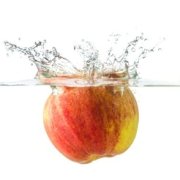Selenium (Se)

Functions and importance for
- Immune defence (especially against virus)
- Cardiovascular system
- Metabolism - production of active T3 hormone (triiodothyronine)
- Antioxidant that protect against cell damage caused by free radicals
- Normal, healthy sperm cells
- Hair and nails
- Promotes the breakdown of cellular waste products (hydrogen peroxide)
- Inhibition of inflammation
- Possibly an anti-cancer agent
- May protect against heavy metals by converting them into insoluble compounds
Deficiencies and poor utilisation may be caused by
- Low-selenium diets
- Lack of vitamin E
- Poisoning
- Smoking
- Infections
- Lack of gastric acid
Deficiency symptoms
Daily selenium intake of 10 micrograms or less may cause one or both of these two rare deficiency diseases:
- Keshan disease - a lethal heart disease caused by the combination of severe selenium deficiency and a virus infection (mutated Coxsackie virus). The disease is named after the Chinese Keshan province and has been eradicated by means of selenium supplementation.
- Kashin-Beck disease - that leads to joint and bone deformities. Often seen in combination with iodine deficiency.
Recent studies even suggest that selenium deficiency may result in:
- Poor sperm quality
- Cardiovascular disease
- Inflammation (rheumatoid arthritis, asthma)
- Cataract
- Increased risk of infections (mainly virus)
- Increased risk of cancer
Cardiovascular disease
Swedish cardiologists have published a study in which they demonstrated that daily supplementation with 200 micrograms of selenium yeast in combination with 200 mg of coenzyme Q10 lowered the number of cardiovascular deaths by 54% among older men and women (in comparison with a group of controls who were given placebo)
Cancer
For decades, it has been assumed that a minor selenium deficiency may increase the occurrence of several types of cancer. Nonetheless, the jury is still out on the question about daily recommendations. The American researcher Larry C. Clark conducted a large study in which he showed that supplementation with 200 micrograms of selenium yeast could reduce the risk of cancer by 37% and cut cancer mortality in half.
A report that was made by a group of researchers from the Technical University of Denmark (DTU) states that daily intake of 200 micrograms of selenium may lower the risk of prostate cancer.
Selenium is believed to have several mechanisms for cancer prevention. In most studies where selenium has been shown to protect against cancer, researchers have used selenium yeast.
Agriculture
Farmers have known for ages that selenium-deficient animals (cattle, swine, and chickens) have impaired fertility and many miscarriages. Also, they suffer from joint inflammation, muscle degeneration, and liver damage. In order to avoid these problems, farmers supplement their animals with selenium. In Finland the government made selenium enrichment of artificial fertilisers mandatory as a way of increasing selenium uptake/intake through the entire food chain.
Sources
Mainly maritime sources such as fish and shellfish, liver and other types of organ meat, meat, eggs, Brazil nuts, beans, and broccoli. Smaller amounts of selenium are found in dairy products, nuts, whole-grain, garlic, fruit, and vegetables. Selenium levels in crops vary depending on where they have grown.
Selenium content in micrograms per 100 grams
| Brazil nuts | 103 |
| Tuna | 70 |
| Eggs | 22 |
| Calf liver | 12 |
| Avocado | 7 |
Recommended daily allowance (RDA)
The actual need for selenium has not been established
Adults: 11 years of age and older: 50-70 micrograms
Children: 1-10 years of age: 20-40 micrograms
Inorganic and organic selenium
The selenium in the soil is inorganic but it gets absorbed by plants and converted to organic selenium compounds. Selenium from vegetable and animal sources is organic and may be bound to amino acids like methionine and cysteine.
In nutritional supplements selenium may be either inorganic or organic. Organic selenium compounds are absorbed more readily and embedded in the different selenium-dependent enzymes and selenoproteins.
Selenium (organic): Selenium yeast, selenomethionine, and selenium amino acid chelate.
Selenium (inorganic): Sodium selenite, sodium selenate.
Vitamin C inhibits the uptake of inorganic selenium, which is why supplements with inorganic selenium (sodium selenite) are most likely infective in multivitamins and other combinations with vitamin C.
Scientific studies are primarily conducted with selenium yeast because of its superior bio-availability.
Increased need
- Low intake of selenium containing foods
- The above listed deficiency symptoms
Overdosing - side effects
Selenium is considered to be safe at daily intake levels up to 300 micrograms. Minor signs of overdosing are seen at doses of around 1,000 micrograms per day, particularly when taken as supplements. Symptoms are typically mild and temporary.
- Headache, dizziness, abdominal pain, constipation, nausea
- Skin rash, brittle hair, and nail deformities (in rare cases)
Excess selenium is excreted in the urine. People with serious kidney diseases should therefore be careful when taking selenium supplements.
In the case of selenium overload (poisoning), the nutrient is excreted via the lungs. This causes garlic-like breath.
Important information
In Europe the natural selenium intake is considerably lower than in other countries because of soil conditions and dietary habits. In the United States (especially the northern regions) the average natural selenium intake is in the range of 60 to 220 micrograms daily. In Denmark, the average women gets 38 micrograms daily, while the average intake among Danish men is 48 micrograms. It is estimated that around 20% of the Danish population gets less than the recommended 55 micrograms of selenium per day. Selenium is a powerful antioxidant. It is recommended to take selenium supplements in combination with vitamin E and other antioxidants.
- Created on .












 "After about one week of taking the Q10 supplement I could feel a huge difference," says 23-year old Alan Piccini, who has been suffering from extreme fatigue and muscle aches ever since he was a child.
"After about one week of taking the Q10 supplement I could feel a huge difference," says 23-year old Alan Piccini, who has been suffering from extreme fatigue and muscle aches ever since he was a child. “Taking capsules with co-enzyme Q10 has freed me of the severe side effects of my cholesterol lowering medicine,” Mrs Franken explains.
“Taking capsules with co-enzyme Q10 has freed me of the severe side effects of my cholesterol lowering medicine,” Mrs Franken explains.